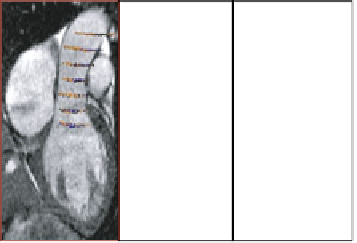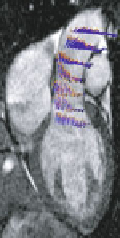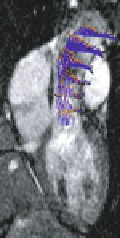Biomedical Engineering Reference
In-Depth Information
Γ
out
Ω
Γ
wall
Γ
in
Fig. 12.1.
Left: Blood velocity measured with Magnetic Resonance in the ascending aorta of a
patient (courtesy of M. Brummer, Emory Children's Healthcare of Atlanta). Right: example of a
possible region of interest
Ω
with velocity measures inside the domain
asymmetry would result in highly disturbed flow patterns. Consequently, the flow
patterns, as detected by MRI flow-velocity encoding methodologies (see Fig. 12.1),
have predictive value in determining which BAV morphology variants would be at
greater risk of developing aortic dilatation.
In order to validate this hypothesis, clinical studies have been performed [51, 52]
evaluating the WSS in BAV patients from MRI measurements. WSS is computed by
a finite difference approximation based upon the velocity data and the blood viscos-
ity measure. However, these estimates are clearly affected by both the discretization
error and the noise of the data. Numerical simulations of blood flow can be car-
ried out in the region of interest to improve this computation (see e.g. [53]). In this
context, measures inside the domain of interest are not strictly needed for solving
the incompressible fluid problem, that requires only initial and boundary conditions.
However, they can be merged with the numerical results for obtaining a better esti-
mate of the WSS. This leads to the following problem: How is it possible to incor-
porate velocity (noisy) data available in a domain of interest into the computation
of the incompressible Navier-Stokes equations? A similar problem in the context of
the fluid mechanics of the heart has been studied in [34] (and successively analyzed
in [54]). In this work, available velocity data belong to a plane cutting the domain.
As it has been observed in [34, 55], in principle, if the data belong to surfaces that
split the region of interest into regular subdomains (as a plane), an immediate ap-
proach for the assimilation would be to solve the equations in each subdomain. In
fact, the available data can be prescribed as standard boundary conditions. This naive
approach, however, does not consider the presence of the noise. As a matter of fact,
no filtering is introduced in this way and the noise is spread into each subdomain,
resulting in significant inaccuracies (see [55]). For this reason, we resort here to a
variational approach.
12.2.1 Mathematical formulation and numerical approximation
Let us denote by
d
3, however
here we limit numerical results to the 2D case). We assume that the domain of in-
Ω
a domain in
R
(
d
=
2
,
3; in real applications
d
=
















































